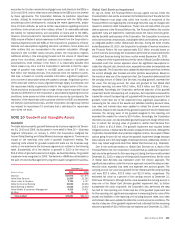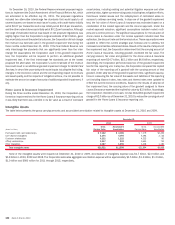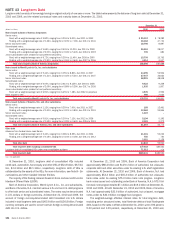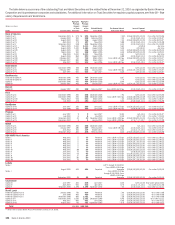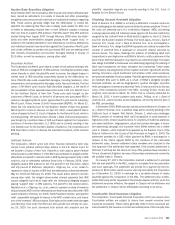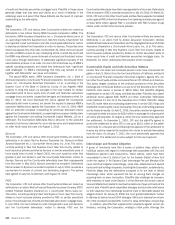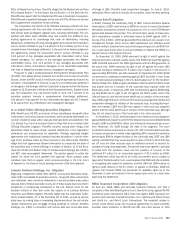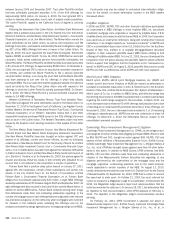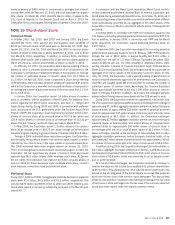Bank of America 2010 Annual Report Download - page 201
Download and view the complete annual report
Please find page 201 of the 2010 Bank of America annual report below. You can navigate through the pages in the report by either clicking on the pages listed below, or by using the keyword search tool below to find specific information within the annual report.Indemnifications
In the ordinary course of business, the Corporation enters into various
agreements that contain indemnifications, such as tax indemnifications,
whereupon payment may become due if certain external events occur, such
as a change in tax law. The indemnification clauses are often standard
contractual terms and were entered into in the normal course of business
based on an assessment that the risk of loss would be remote. These
agreements typically contain an early termination clause that permits the
Corporation to exit the agreement upon these events. The maximum potential
future payment under indemnification agreements is difficult to assess for
several reasons, including the occurrence of an external event, the inability to
predict future changes in tax and other laws, the difficulty in determining how
such laws would apply to parties in contracts, the absence of exposure limits
contained in standard contract language and the timing of the early termina-
tion clause. Historically, any payments made under these guarantees have
been de minimis. The Corporation has assessed the probability of making
such payments in the future as remote.
Merchant Services
On June 26, 2009, the Corporation contributed its merchant processing
business to a joint venture in exchange for a 46.5 percent ownership interest
in the joint venture. During the second quarter of 2010, the joint venture
purchased the interest held by one of the three initial investors bringing the
Corporation’s ownership interest up to 49 percent. For additional information
on the joint venture agreement, see Note 5 – Securities.
The Corporation, on behalf of the joint venture, provides credit and debit
card processing services to various merchants by processing credit and debit
card transactions on the merchants’ behalf. In connection with these ser-
vices, a liability may arise in the event of a billing dispute between the
merchant and a cardholder that is ultimately resolved in the cardholder’s
favor and the merchant defaults on its obligation to reimburse the cardholder.
A cardholder, through its issuing bank, generally has until the later of up to six
months after the date a transaction is processed or the delivery of the product
or service to present a chargeback to the joint venture as the merchant
processor. If the joint venture is unable to collect this amount from the
merchant, it bears the loss for the amount paid to the cardholder. The joint
venture is primarily liable for any losses on transactions from the contributed
portfolio that occur after June 26, 2009. However, if the joint venture fails to
meet its obligation to reimburse the cardholder for disputed transactions,
then the Corporation could be held liable for the disputed amount. In 2010
and 2009, the joint venture processed and settled $265.5 billion and
$250.0 billion of transactions and it recorded losses of $17 million and
$26 million.
At December 31, 2010 and 2009, the Corporation, on behalf of the joint
venture, held as collateral $25 million and $26 million of merchant escrow
deposits which may be used to offset amounts due from the individual
merchants. The joint venture also has the right to offset any payments with
cash flows otherwise due to the merchant. Accordingly, the Corporation
believes that the maximum potential exposure is not representative of the
actual potential loss exposure. The Corporation believes the maximum po-
tential exposure for chargebacks would not exceed the total amount of
merchant transactions processed through Visa and MasterCard for the last
six months, which represents the claim period for the cardholder, plus any
outstanding delayed-delivery transactions. As of December 31, 2010 and
2009, the maximum potential exposure totaled approximately $139.5 billion
and $131.0 billion. The Corporation does not expect to make material pay-
ments in connection with these guarantees. The maximum potential exposure
disclosed does not include volumes processed by First Data contributed
portfolios.
Other Derivative Contracts
The Corporation funds selected assets, including securities issued by CDOs
and CLOs, through derivative contracts, typically total return swaps, with third
parties and SPEs that are not consolidated on the Corporation’s Consolidated
Balance Sheet. At December 31, 2010 and 2009, the total notional amount
of these derivative contracts was approximately $4.3 billion and $4.9 billion
with commercial banks and $1.7 billion and $2.8 billion with SPEs. The
underlying securities are senior securities and substantially all of the Corpo-
ration’s exposures are insured. Accordingly, the Corporation’s exposure to
loss consists principally of counterparty risk to the insurers. In certain
circumstances, generally as a result of ratings downgrades, the Corporation
may be required to purchase the underlying assets, which would not result in
additional gain or loss to the Corporation as such exposure is already reflected
in the fair value of the derivative contracts.
Other Guarantees
The Corporation sells products that guarantee the return of principal to
investors at a preset future date. These guarantees cover a broad range of
underlying asset classes and are designed to cover the shortfall between the
market value of the underlying portfolio and the principal amount on the preset
future date. To manage its exposure, the Corporation requires that these
guarantees be backed by structural and investment constraints and certain
pre-defined triggers that would require the underlying assets or portfolio to be
liquidated and invested in zero-coupon bonds that mature at the preset future
date. The Corporation is required to fund any shortfall between the proceeds
of the liquidated assets and the purchase price of the zero-coupon bonds at
the preset future date. These guarantees are recorded as derivatives and
carried at fair value in the trading portfolio. At December 31, 2010 and 2009,
the notional amount of these guarantees totaled $666 million and $2.1 billion.
These guarantees have various maturities ranging from two to five years. As of
December 31, 2010 and 2009, the Corporation had not made a payment
under these products and has assessed the probability of payments under
these guarantees as remote.
The Corporation has entered into additional guarantee agreements and
commitments, including lease-end obligation agreements, partial credit guar-
antees on certain leases, real estate joint venture guarantees, sold risk
participation swaps, divested business commitments and sold put options
that require gross settlement. The maximum potential future payment under
these agreements was approximately $3.4 billion and $3.6 billion at Decem-
ber 31, 2010 and 2009. The estimated maturity dates of these obligations
extend up to 2033. The Corporation has made no material payments under
these guarantees.
In addition, the Corporation has guaranteed the payment obligations of
certain subsidiaries of Merrill Lynch on certain derivative transactions. The
aggregate notional amount of such derivative liabilities was approximately
$2.1 billion and $2.5 billion at December 31, 2010 and 2009. In the normal
course of business, the Corporation periodically guarantees the obligations of
its affiliates in a variety of transactions including ISDA-related transactions
and non ISDA-related transactions such as commodities trading, repurchase
agreements, prime brokerage agreements and other transactions.
Bank of America 2010 199




